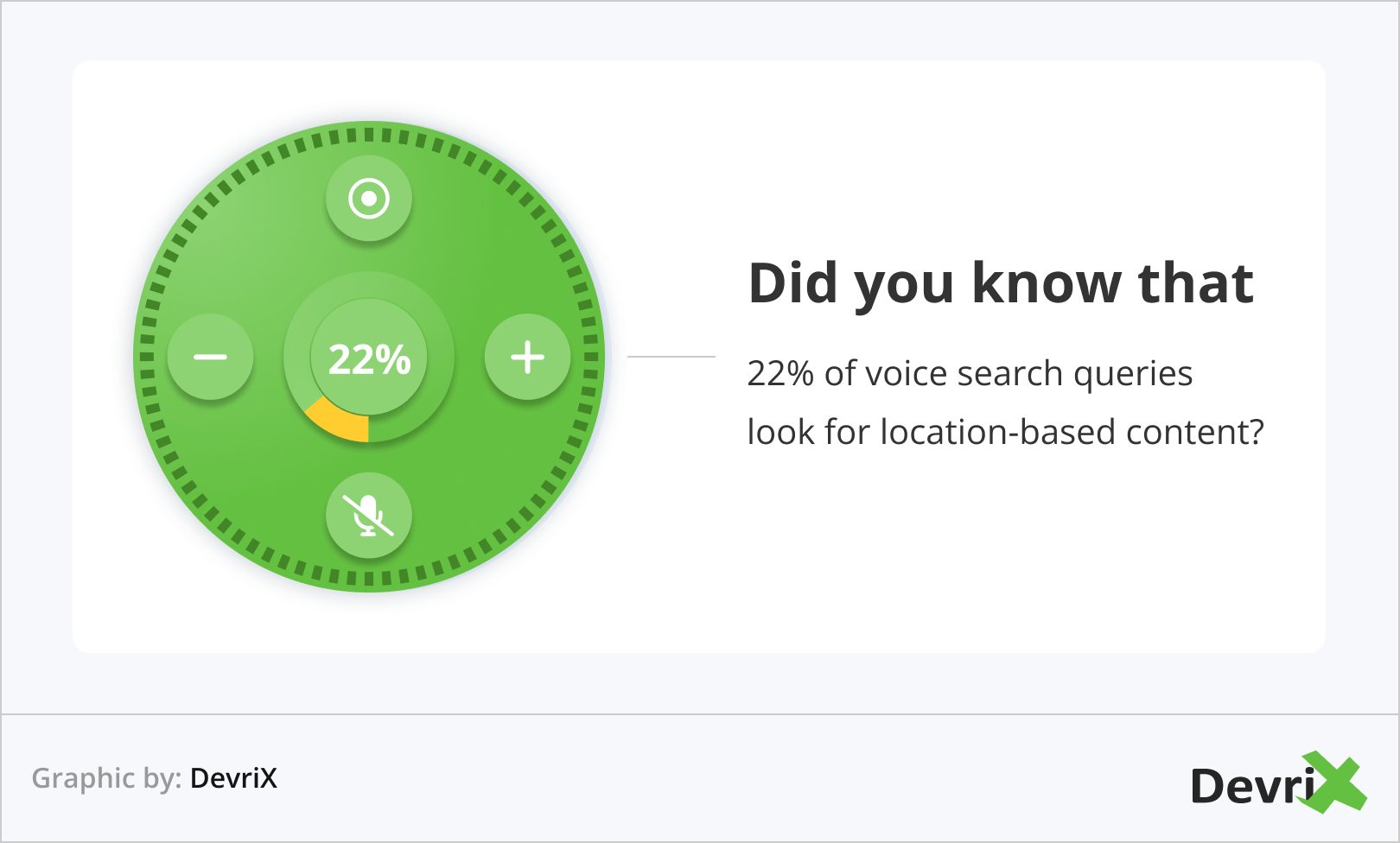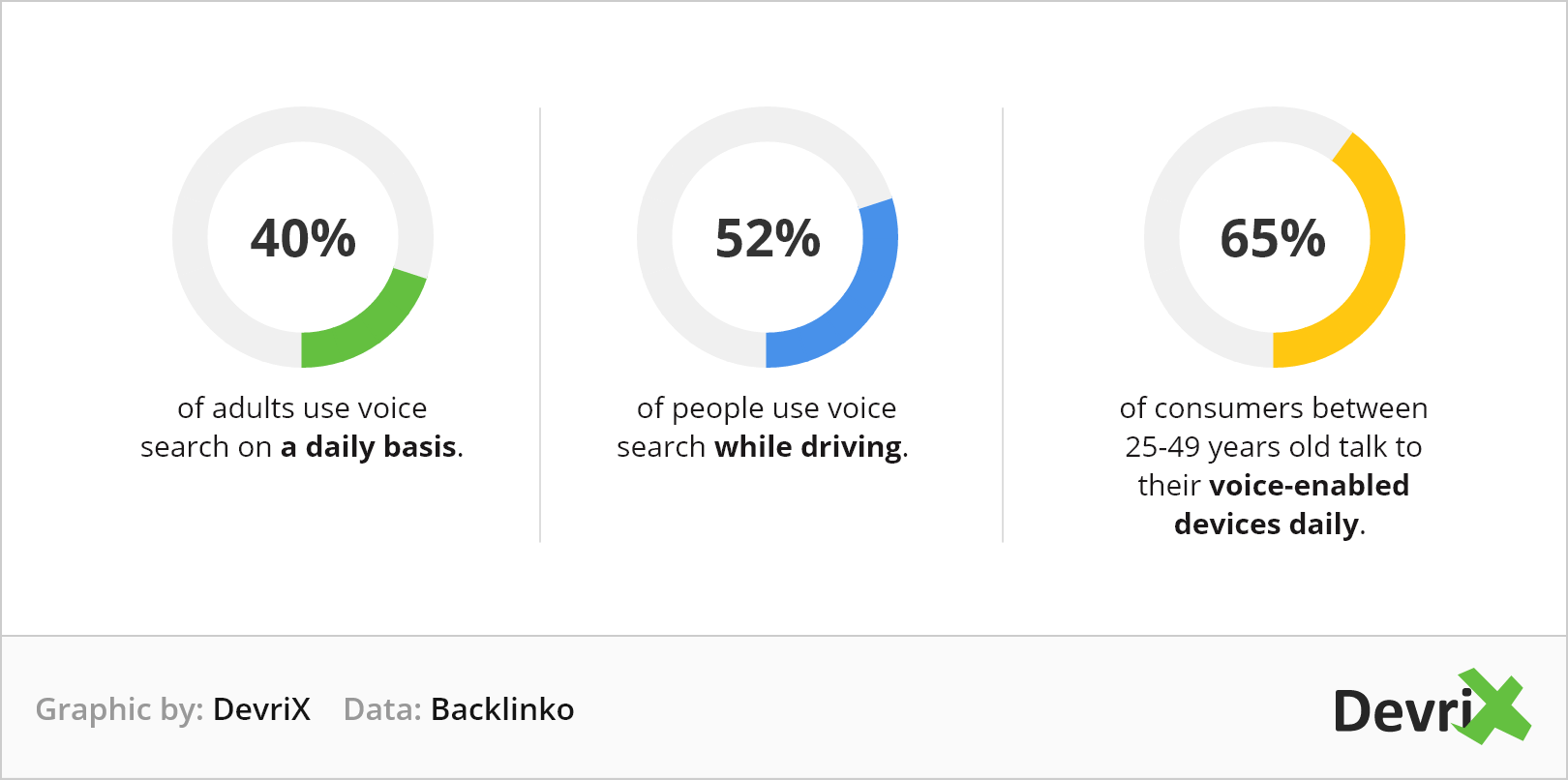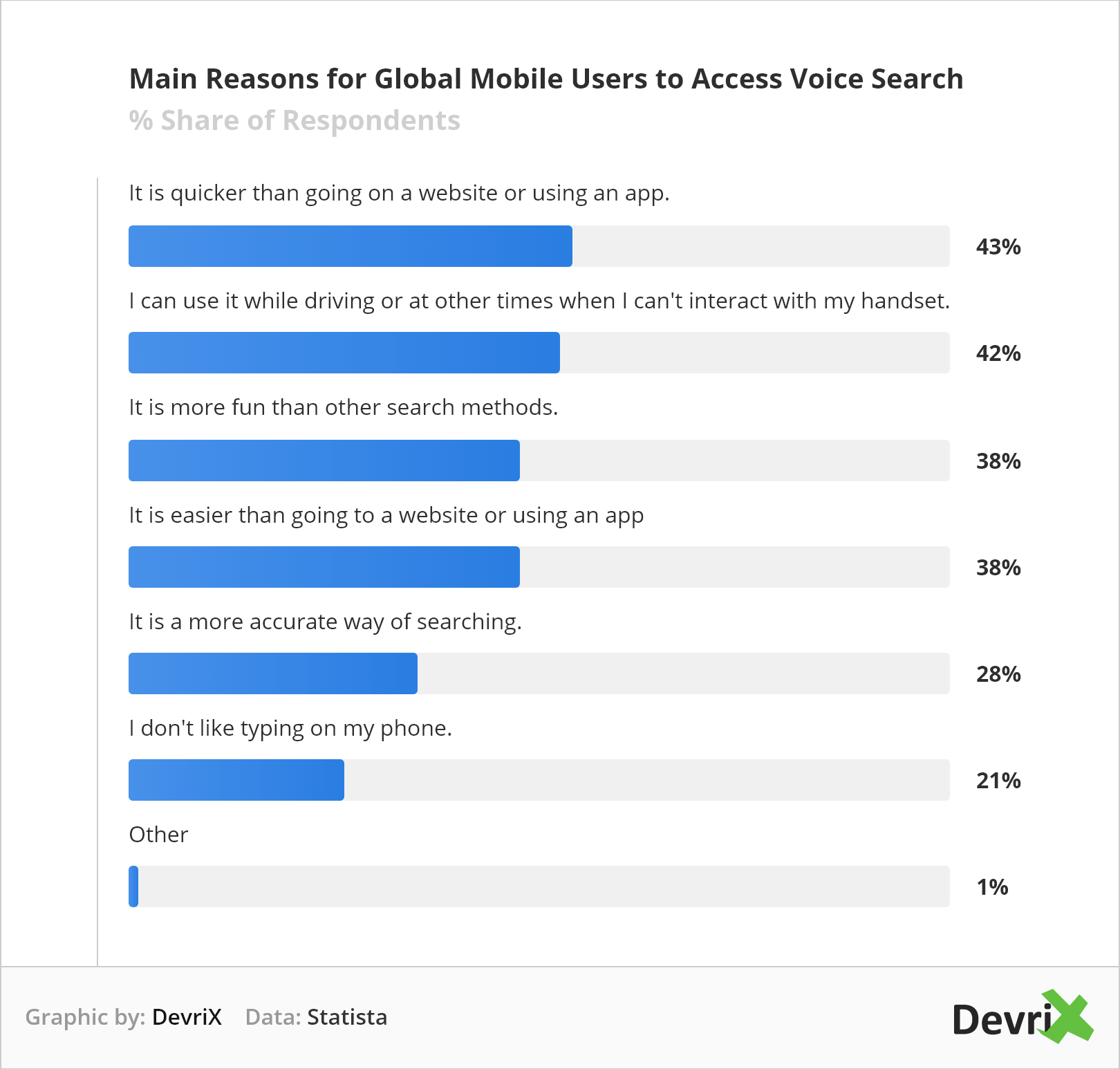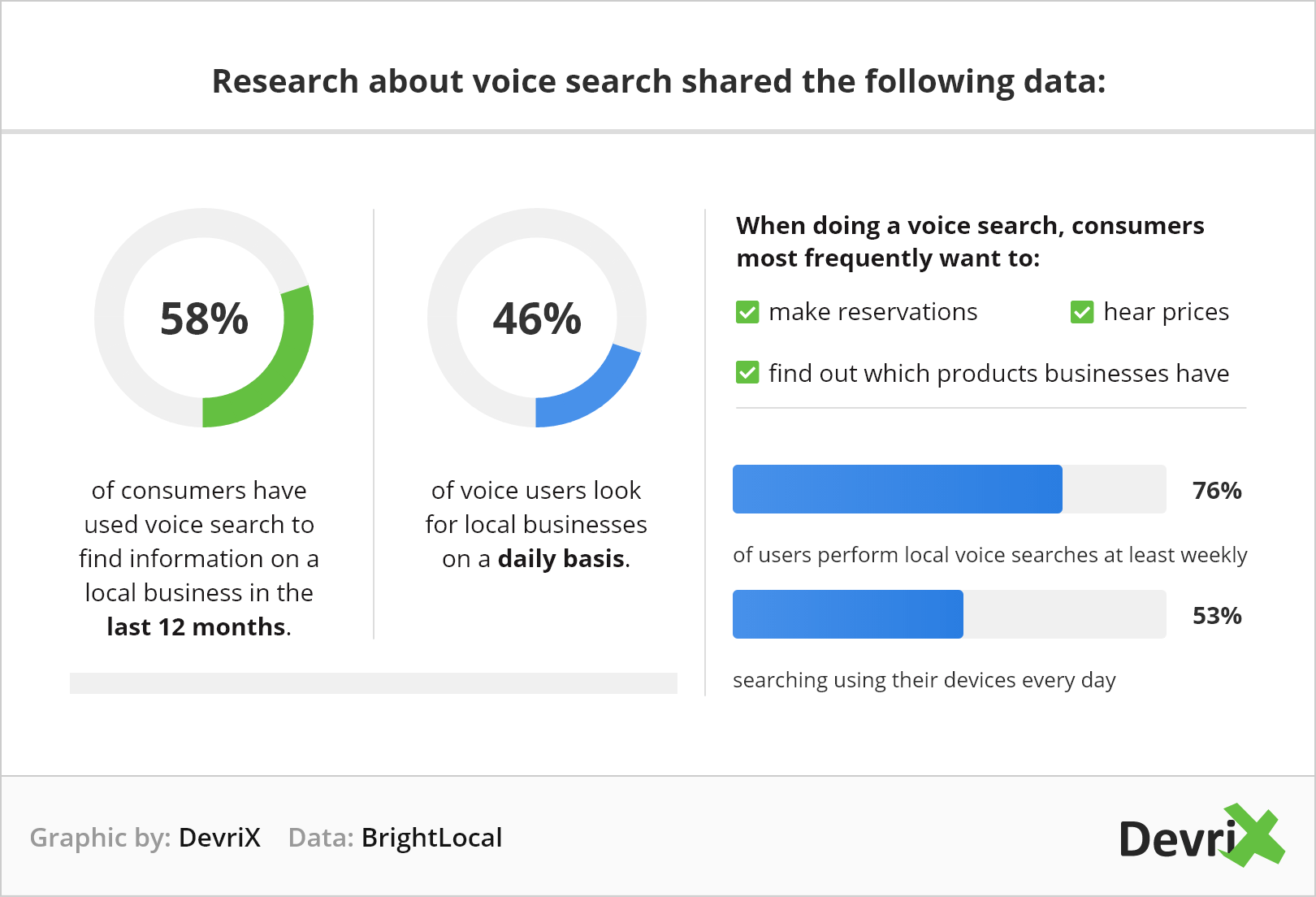In 2022, voice search optimization is a must for every business that wants to stay on the customer’s radar.
Virtual assistants, or voice assistants, have become an integral part of the everyday lives of millions of people over the world in the past decade. The technology is convenient, easy to use, and affordable.
Aside from helping with stuff around the house, such as controlling the connected internet of things (IOT) devices, and playing music, people use voice assistants to search information online.
However, googling on the go and asking your voice assistant things is not the same as keying in search terms on your phone or laptop. In the first case, you act as if you are talking to another sentient being, and in the second, you give commands to a computer.
While in both cases there is an algorithm on the other end of the line, verbal communication makes the situation feel more natural and casual. And that’s what makes voice search different, and optimizing for it is such a challenge.
To make their content discoverable regardless of the device and method the person is using, businesses need to understand voice search SEO, and optimize their content in a timely manner.
In this guide, we provide everything you need to know on the topic. So read on and take notes!
What Is Voice Search?
Voice search allows you to perform a search on the internet by verbally stating a specific question to your smartphone or voice enabled devices.
It is a feature that more and more businesses are optimizing their websites to rank for in search engines. And for those that are not, it’s about time they did.
If you are not convinced of how popular voice search actually is, just think about the fact that more than 90 million adult Americans use voice assistants. Furthermore, the smart speaker market is expected to grow at 21% CAGR until 2025.
Statistics gathered by Backlinko show that:
- 40% of adults use voice search on a daily basis.
- 52% of people use voice search while driving.
- 65% of consumers between 25-49 years old talk to their voice-enabled devices daily.
According to Statista, the main reason people prefer to use voice search is that it’s quicker than typing in a search engine.
In a nutshell, voice search optimization is definitely something any business should care about.
Top 5 Voice Search Devices
Before listing strategies on how to optimize your website for voice search SEO, let’s have a look at the most important devices and virtual assistants. This will help you obtain a better understanding of how these devices work and what are the additional features they have.
1. Amazon Alexa and Echo
Alexa is a virtual assistant by Amazon. It works by you asking it questions or giving it commands. Usually, the Alexa devices can be activated with wake-words like “Alexa” or “Amazon”, or “Alexa wake”. The statistics show Amazon Echo gets 64% of queries answered correctly.
Alexa is capable of playing radio, streaming music, setting timers and alarms, getting tailored news, asking questions, controlling smart devices at home, making calls, playing games, audiobooks, tracking real-time information, and more.
You can also extend Alexa’s functions by installing additional apps that are called “skills”. There is a collection of different skills you can install. Some of them are:
- Spotify
- Amazon Storytime suitable for kids
- Ambient Sounds for chilling out or for falling asleep
- Todoist an app used to organize your to-do list
- Xbox for games
- Allrecipes for people who love cooking
2. Google Home and Google Assistant
Google Home is the smart speaker by Google that uses artificial intelligence to answer specific questions. It’s actually the winner in the search accuracy test by answering 81% of the queries correctly compared to the other virtual assistants.
The device enables users to speak voice commands and to interact with services through Google Assistant. Part of the Google Home family is Google Home, Nest Mini, Home Max, Nest Hub, and the Nest Hub Max.
The Google Home app helps you to control all of its devices and is similar to the Amazon Alexa device.
Some of the main Google Home skills are:
- WhatsApp – you can dictate your message instead of writing it
- Weather information
- Google Podcasts
- Philips Hue for turning on and off the lights
- Spell Check
- Google Assistant interpreter mode
- Android apps command
- I’m Home Routine which enables “I am home” mode by turning on the lights, playing music or anything else you program it to do.
3. Siri and Apple
Siri is a personal assistant by Apple. Similarly to the previous devices, it provides a wide range of options. Siri can read the news, inform you about sports, make calls, send messages, help with organization, give answers to questions, etc.
Usually, you can use the command “Hey Siri” to activate it. There is the HomePod which is a device for smart homes, similar to Alexa and Google Home.
Some of the skills you can enable are:
- Reading appointments or schedule
- Creating list and reminders
- Sending text messages and make phone calls
- Giving directions
- Setting timers, reminders and alarms
- Turning lights on and off
- Asking questions
- Or having fun asking Siri to tell you a joke
4. Bixby and Samsung
Bixby is a virtual assistant built by Samsung. Like the other assistants, you can use it to get information about the weather, news, or anything you need to know at a particular moment.
Some of the Bixby features are:
- Connect with your TV
- Control home devices
- Sync with Facebook and Messenger, Youtube, Instagram, Twitter
- CNN
- Expedia
- Google Play Store and Google Play music
- Uber
- Pandora
5. Microsoft Cortana
Cortana is Microsoft’s virtual assistant that can help with requests, tasks, reminders and more. By enabling “Hey, Cortana” you can do searches, book meetings, set up reminders, or create your to-do lists.
One of its cool features is for business meetings. It can pull helpful information from LinkedIn such as professional backgrounds and company details so you can have context for your meeting.
Some of the main skills are:
- Reminders
- Track teams, flights, interests
- Send emails and messages
- Manage calendar
- Play music, radio, podcasts
- Find info about everything you ask – places, restaurants, facts
Understanding Voice Search – How Does It Work?
In order to implement voice search optimization on your website, first, you need to understand how it works. When you search for something verbally, the voice assistant, based on artificial intelligence, recognizes your voice and turns your words into code.
The voice assistant analyzes the speech and, once processed, the text is sent to search engines to find the results of your question. In the end, the information is translated and given back to you.
Artificial intelligence controls voice search engines and, using machine learning, it becomes smarter every time a person uses it. The process takes about 1-2 seconds with the help of artificial intelligence technology and with the development of natural language processing (NLP).
Thanks to NLP, search engines can better recognize natural speech and, thus, can further optimize the results for any specific search query.
What Do You Need to Know About Voice Search SEO?
The most important thing you need to know about voice searches is that they are conversational. This means that in voice search results,questions and simple answers are prioritized.
The algorithm is trying to deliver relevant and concise results that provide the most accurate answer to the user question in the fewest words.
Furthermore, voice search queries themselves are natural and consist of longer sentences, also known in SEO as long-tail keywords. Web search, on the other hand, is usually done via short and basic search terms.
Let’s say you want to order a pizza. With a search engine, you might normally key “Pizza delivery” or “Pizza delivery in New York”, but in a voice query you’d say “Where’s the closest pizza restaurant?” or “Find a pizza restaurant near me”.
Keep in mind that for both queries you might have different results. This is very important for voice search optimization.
Did you know 22% of voice search queries look for location-based content? This is essential if you run a restaurant, local shop, bakery, etc. If your business is somehow location-related, optimizing your content for short and sweet answers could bring in more customers.

How to Implement Voice Search Optimization?
As mentioned, voice search should be a significant part of your marketing plan, especially if your business is local. People often search while driving, on the go, or simply when they are not able to type, like coming home after shopping with their hands full.
Keep in mind that location-based searches are among the most common ones, but 52% of voice-activated speaker owners also want to get information about promotions and deals.
So if you really want to stand out in the crowd and beat your competitors, you should consider voice search optimization when developing your marketing plan.
Let’s look at the four basic voice search SEO strategies you can use to make your content easier to understand by the algorithms:
1. Write Your Content in a Conversational Tone
One of the most important ways to optimize for voice search is to use natural language and conversational tone. Since people tend to think of the virtual assistants as a friend who they speak with, the tone is casual and natural.
This means that the content on your website should be written this way so it can answer customer’s questions. Try to figure out user intent and focus on providing helpful and valuable information.
Focus on long-tail keywords that are close to the way a person speaks, and will ask a question in verbal form, since this is the way people tend to speak to their digital assistants.
Voice search queries are longer than the traditional ones and ultra-specific. “How to cook a chocolate cake” is definitely a question that you would ask your digital assistant.
To better understand the differences between voice and browser search, check out the following example:

When using a browser, most probably you will search by keying in “Chocolate cake recipe”.

As you can see, some of the results match, but not all of them. And this is normal since the keywords used are different, therefore, so are the SERPs.
2. Optimize for Featured Snippets and Use Schema Markup
Featured snippets appear at the top of the SERPs, a.k.a the position zero. When you type a query, Google may extract the content it’s algorithm considers the most relevant, and place it in a box, before the rest of the links.
In order to rank higher in Google Search, you need to provide quality data and optimize it properly so that Google may choose to present it in a featured snippet. You can do this by creating useful content that answers directly to specific questions, and provide relevant and concise paragraphs, tables, and bullets that match common queries.
This is what you can do:
- Create content that answers questions, such as a FAQ page.
- Update your old content often.
- Use long-tail keywords with questions in your H1 and H2 tags.
- Answer questions on your Google My Business section dedicated to Questions and Answers.
- Create compelling questions and answers about your products and services.
Some other things you can do to improve your voice search SEO are:
- Submit XML sitemaps to Google Search Console
- Optimize your meta descriptions so it is readable by search engines
- Improve your website structure
3. Improve Your Local SEO
As mentioned, voice optimization is especially important when it comes to local searches, because people often use it to find businesses near them. By researching what phrasing they use and what questions they ask you can make sure that your content delivers all the right answers.
To better understand how vital voice search SEO is for local businesses, have a look at these research results by BrightLocal:
- 58% of consumers have used voice search to find information on a local business in the last 12 months.
- 46% of voice users look for local businesses on a daily basis.
- When doing a voice search, consumers most frequently want to – make reservations, hear prices, and to find out which products businesses have.
- 76% of users perform local voice searches at least weekly—with 53% searching using their devices every day.
To rank in local search, you need to regularly update the information on your Google My Business page to include the following data:
- Brand name
- Correct address
- Photos
- Contact details
- Working hours
- Reviews

In terms of location-specific content you can optimize your website in the following ways:
- Use local phrases that people might use.
- Add a “Near me” description to your title tags and meta description.
- Add notable features around your location.
- Use words and phrases related to your location or neighborhood.
If you have reviews enabled on Facebook, Google can feature them as well.
4. Increase Your Website Speed and Optimize for Mobile
Nowaday, page speed is vital for SEO, as it is a determinant for user experience. That’s why Google introduced core web vitals as a ranking factor.
Your website speed influences not only your pages’ position in the SERPs but their performance in voice search results as well.
As those searches happen on the go, your customers expect fast results and may need the information right away. Imagine if they are driving a car trying to find your shop, slow answers may cause them to miss it and need to go around in circles. This creates frustration and a really bad experience. Therefore, search engines strive to provide voice assistance with fast and straight-to-the-point results.
To make this possible, boosting your website page’s speed is crucial.
This goes hand in hand with optimizing for mobile. Having a mobile-friendly website is a must, nowadays, and when it comes to voice search SEO, this is even more important.
The reason is that most of the voice searches are done via phones as the customers are on the go.
You can check your website speed on PageSpeed Insights, which will provide you with insights on how to make your mobile site faster.
Wrapping up
When implementing voice search optimization, keep in mind that voice search requires a somewhat different approach than traditional SEO.
The key takeaway is to remember that people see their digital assistants as if they were humans, and therefore search differently when searching verbally. And that means conversational long-tail keywords are necessary when answering your customers’ queries.
If you manage to provide the answers they need in a to-the-point and accurate way, you have better chances to help your content rank.








